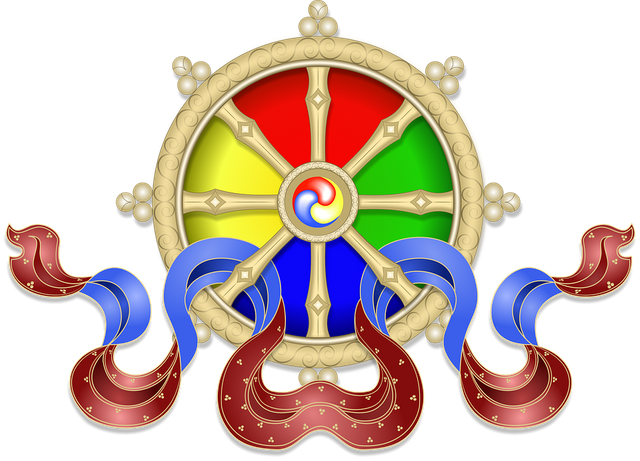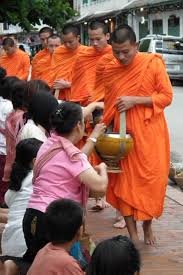The Dharma and The Sangha (a brief overview)

The Dharma
Buddha preached that existence was a continuing cycle of death and rebirth. Each person's position and well-being in life was determined by his or her behavior in previous lives. For example, good deeds may lead to rebirth as a wise and wealthy person or as a being in heaven. A person's evil deeds may lead to rebirth as a poor and sickly person or even in hell.
Buddha also taught that as long as individuals remain within the cycle of death and rebirth, they can never be completely free from suffering. Buddha said people could break out of the cycle by eliminating any attachment to worldly things. By ridding themselves of such attachment, people would gain a kind of perfect peace and happiness. Buddha called this state of peace and happiness Nirvana. According to Buddha, those who are willing and able to follow the Middle Way and the Noble Eightfold Path will conquer their attachment to worldly things and thus achieve Nirvana.
The Middle Way is a way of life that avoids both the uncontrolled satisfaction of human desires and the extreme forms of self-denial and self-torture.
The Four Noble Truths
The Buddha gave his first teaching after his enlightenment in India at Saranath. This first turning if the wheel of Dharma was a teaching on the Four Noble Truths.
(1)The truth of suffering
The Buddha taught that being born in one of six realms of Samsara ( or cyclic existence ) is the result of karma, and therefore this existence is, at its root, suffering. The six realms are the possible types of rebirths for beings in Samsara and are: the God realm in which gods have great pride, the Asura realm in which the jealous gods try to maintain what they have, the Human realm or desire realm, which is the best realm because one has the possibility of achieving enlightenment, the Animal realm characterized by stupidity, the Hungry Ghost realm characterized by great craving, and the Hell realm characterized by aggression.
(2)The truth of the cause of suffering
Buddha taught that the cause of suffering is grasping to that which is impermanent. All phenomena which has a cause is impermanent. Therefore, the cessation of suffering is non-attachment, “the path”. These truths are the foundation of Buddhism.
The Noble Eightfold Path
The noble eightfold path consists of
- Right View (knowledge of the truth)
- Right Intention (the intention to resist evil)
- Right Speech (saying nothing to hurt others)
- Right Action (respecting life, morality, and property)
- Right Livelihood (holding a job that does not injure others)
- Right Effort (striving to free one's mind)
- Right Mindfulness (controlling one's feelings and thoughts)
- Right Concentration (practicing proper forms of concentration)
After Buddha's death, his followers collected the traditions that had developed around the dharma. The oldest of the many Buddhist schools compiled a scripture called the Tripitika. This word means Three Baskets. The first part, the Basket of Discipline, deals with the rules for regulating the order of Buddhist monks. The second part, the Basket of Discourses, consists largely of sermons. The third part, the Basket of the Higher Dharma, contains later and more systematic discussions of doctrine, or Sutras. Later Buddhist schools have added their own scriptures called Shastras.

The Sangha.
The word sangha sometimes refers to the ideal Buddhist community, which consists of those who have reached the higher stages of spiritual development. The word also refers to the order of Buddhist monks and nuns. In addition, the term means the community of monks, nuns, and laity.
The order of monks has always had a special role within the sangha. It has played an important part in preserving and spreading Buddhism. In many Buddhist groups, the discipline of monastic life is considered essential to those who seriously seek nirvana. In most Buddhist countries, monks are expected to live a life of poverty, meditation, and study. Monks are also expected to avoid sexual activity.
Some Buddhists become monks for life, but others serve in the sangha for only short periods of time. The monks wear special robes and are a common sight in all Buddhist countries.
The laity also has an important role in the life of the sangha. Members are expected to honor Buddha, to follow basic moral rules, and to support the monks. They are also expected to pay special honor to images of Buddha and to objects that are associated with him.
Many of the laity have influenced the history of Buddhism. During the 200's B.C., Asoka, an Indian emperor, made Buddhism a kind of state religion. He established a tradition that has led to close relations between religion and government in many Buddhist countries. In 1956, B. R. Ambedkar, an Indian layman, led a mass conversion that brought more than 1 million former Hindus in India into the sangha.
To listen to the audio version of this article click on the play image.

Brought to you by @tts. If you find it useful please consider upvoting this reply.
Any idea how this world started?
Posted using Partiko Android